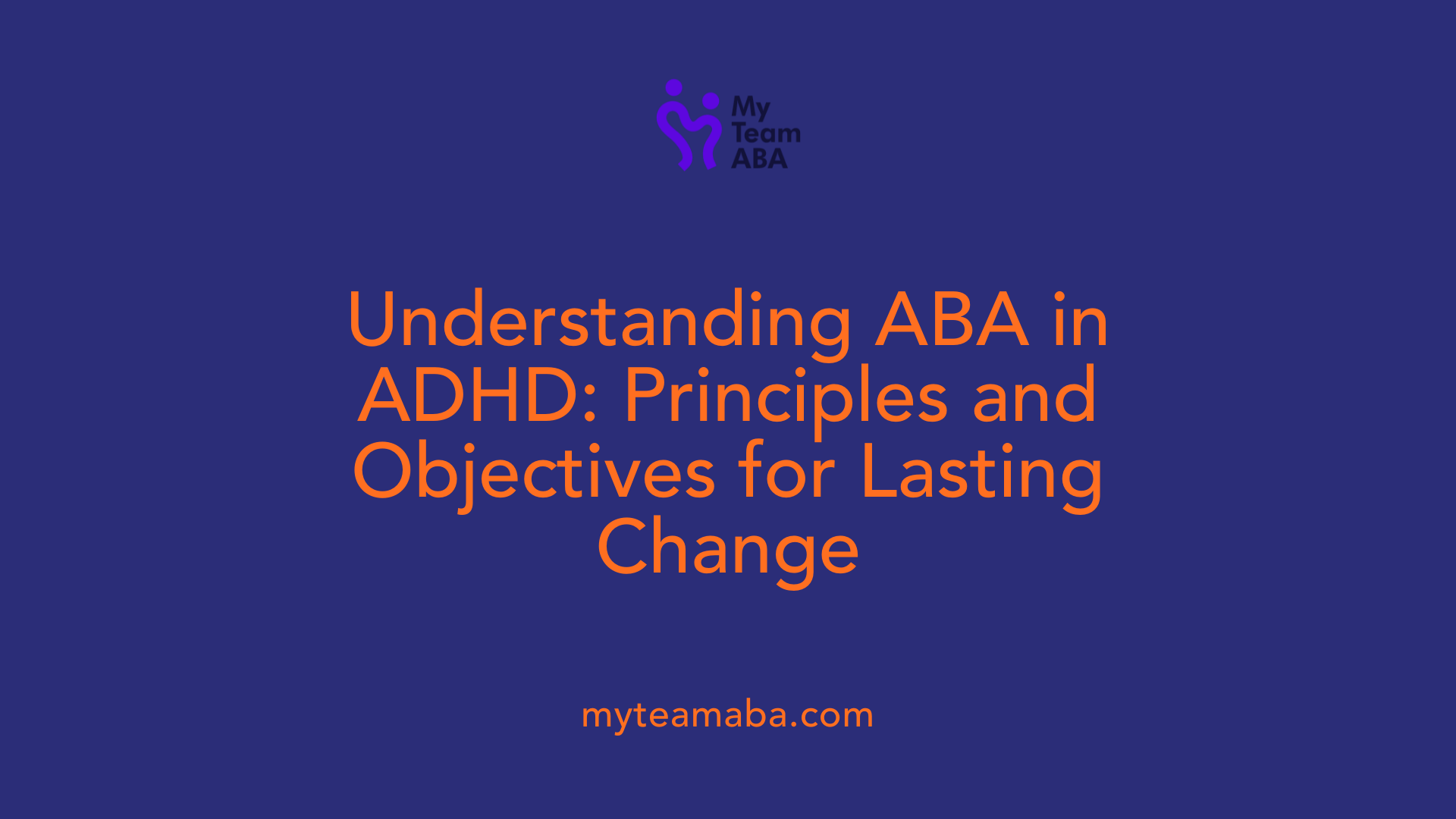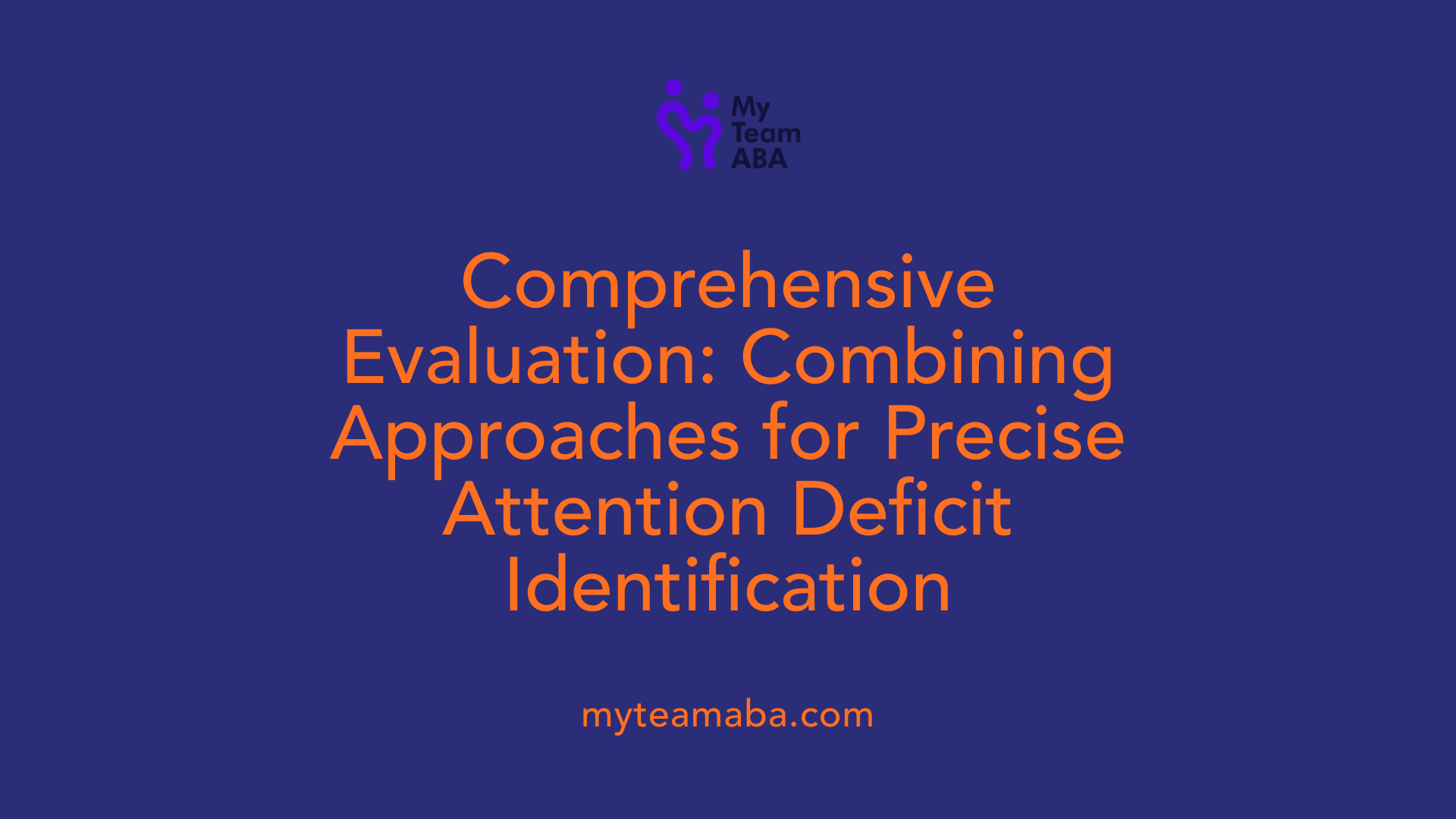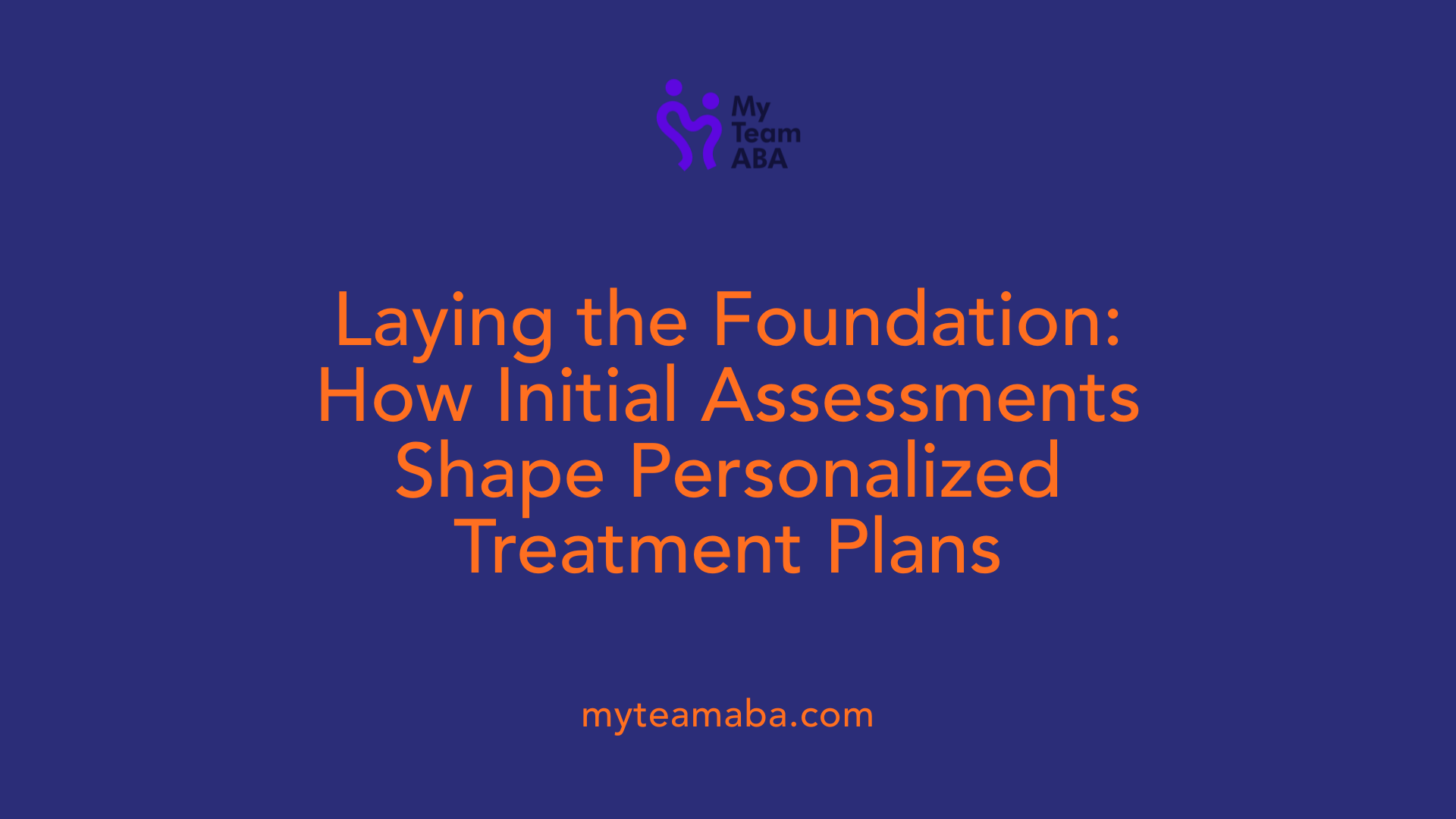Addressing Attention-Deficit Behaviors in an Initial ABA Assessment
June 26, 2025
Optimizing Initial Behavior Assessments for Children with Attention Challenges

Understanding the Foundations of ABA in Addressing Attention Deficits
Addressing attention-deficit behaviors effectively begins with comprehensive initial assessments. These assessments serve as the cornerstone for developing tailored treatment plans that aim to improve focus, reduce impulsivity, and enhance social and cognitive skills in children, particularly those with ADHD. By employing a variety of evidence-based strategies and detailed evaluation processes, practitioners can better understand a child's unique behavioral profile and formulate interventions that promote meaningful progress.
Core Principles and Goals of ABA in ADHD

Fundamentals of Applied Behavior Analysis (ABA)
Applied Behavior Analysis (ABA) is a scientific approach that focuses on understanding and changing behavior through the principles of learning. In the context of ADHD, ABA employs evidence-based techniques to improve attention, social skills, and behavior management. The core of ABA involves identifying the environmental factors influencing behavior, including antecedents (what happens before a behavior) and consequences (what happens after it).
ABA techniques include functional behavioral assessments (FBAs), which help determine why behaviors occur by analyzing the motivation behind actions. This process involves collecting data through observations, interviews, and checklists, enabling practitioners to design personalized intervention strategies.
Behavioral strategies like differential reinforcement, task analysis, and self-management emerge from ABA principles. These aim to increase positive behaviors such as attention and compliance while reducing problematic behaviors like impulsivity or distractibility.
Goals of ABA therapy for children with ADHD
The primary objectives of ABA therapy are to enhance social and communication skills, improve attention span, and foster positive daily routines. In children with ADHD, therapy targets core challenges, including impulsivity, distractibility, and difficulty organizing tasks.
ABA promotes the development of adaptive behaviors through structured routines and reinforcement. Goals also include increasing motivation, encouraging prosocial interactions, and building self-regulation skills. When combined with medication, ABA has been shown to produce more potent and sustained improvements.
Scope of ABA interventions in attention management
ABA interventions for attention management are comprehensive and individualized. Initial assessment involves thorough observation, skill evaluations, and functional analysis to understand each child's unique needs.
Techniques utilized include visual schedules, token systems, social skills training, and self-monitoring tools. For attention-related behaviors, strategies like task analysis break complex tasks into manageable steps, making it easier for children to stay engaged.
Consistent implementation across settings—home, school, and therapy—is vital. Parental involvement through behavioral parent training ensures that gains are generalized and maintained.Long-term progress is achieved through routine data collection, ongoing analysis, and adjusting intervention strategies to adapt to evolving needs.
Assessment Techniques and Tools for Attention Evaluation

What techniques and processes are used to evaluate attention-related behaviors during initial ABA assessments?
During initial ABA assessments, evaluating attention-related behaviors is essential to understanding a child's specific challenges and strengths. One primary method employed is the Functional Behavioral Assessment (FBA), which involves collecting information through interviews with parents, teachers, and caregivers. Direct observations of the child's behavior in different settings are also crucial. These observations help identify patterns, triggers, and functions behind attention-seeking actions.
In addition to FBA, standardized assessments such as the Rapid Assessment of Attention Types (RAAT) are often used. The RAAT breaks down the environment into sections with various attention stimuli to observe how children respond and shift their focus. Through these structured observations, clinicians can pinpoint whether attention issues stem from distractibility, motivation, or environmental factors.
Behavioral checklists and scoring systems are used alongside these assessments. These tools record the child's attention span, response to prompts, and engagement levels in real time. The data collected provides a comprehensive picture, guiding tailored intervention strategies.
Overall, the combination of functional assessments, standardized testing like RAAT, and meticulous data collection allows clinicians to understand attention behaviors deeply and plan targeted, effective interventions.
Integrating Multifaceted Assessment Approaches for Accurate Identification

How are attention-deficit issues identified during ABA evaluations in children?
Attention-deficit issues in children are typically identified through thorough evaluations that include functional behavior assessments (FBAs). These assessments analyze the environmental triggers, the behaviors themselves, and the consequences that maintain attention difficulties. Observers monitor the child's ability to focus, their responses to different stimuli, and how consistently these behaviors occur across various settings.
Practitioners often use direct observation methods and data collection tools like ABC (Antecedent-Behavior-Consequence) charts to gather precise information. Additionally, structured procedures such as functional analysis help explore the motivation behind attention-related behaviors. This detailed process helps professionals develop a clear understanding of specific factors influencing attention, enabling the creation of tailored intervention strategies.
Overall, the identification process involves observing behavior in context, analyzing data, and considering environmental influences to accurately pinpoint attention challenges faced by children with ADHD.
Developing Effective Treatment Plans Based on Initial Assessments

What is the role of initial assessments in developing treatment plans for children with attention-deficit behaviors?
Initial assessments are essential for creating personalized and effective treatment plans for children experiencing attention-deficit behaviors. They provide a detailed understanding of the child's behavioral, cognitive, and emotional profile, which is vital for tailoring interventions.
These assessments involve a combination of indirect methods, such as interviews with parents, teachers, and caregivers, along with direct observations of the child's behavior in various settings. Tools like functional behavior assessments (FBAs) and skills assessments help identify specific behaviors, their triggers, and the underlying functions.
By understanding the root causes of problematic behaviors, therapists can set appropriate goals and select strategies that address individual needs. For example, if a child displays impulsivity due to difficulty with self-regulation, the treatment plan can incorporate self-management training and social skills development.
Assessment data also aid in pinpointing skill deficits and strengths, enabling a focus on building positive habits while reducing challenges. For example, a child may excel in language skills but struggle with organizational tasks. The plan can then emphasize improving attention span and executive functioning skills through structured routines and reinforcement techniques.
In summary, initial assessments serve as the foundation for evidence-based, personalized treatment plans. They ensure that interventions are not only targeted but also adaptable over time as the child's needs evolve.
How do goals formation and identification of skill deficits influence therapy?
Setting clear, measurable goals is a direct outcome of a comprehensive assessment. Goals for children with ADHD typically include increasing attention duration, reducing impulsive actions, and enhancing social interactions. Identifying specific skill deficits—such as difficulty following multi-step instructions or trouble with emotional regulation—guides the focus of therapy.
When therapists understand a child's unique profile, they can design interventions like discrete trial training or differential reinforcement to target these particular areas. For example, if a child struggles with task completion, strategies might include breaking tasks into smaller steps via task analysis.
Additionally, recognizing strengths allows clinicians to leverage existing skills to foster confidence and motivation. A balanced approach ensures a more engaging and effective treatment process.
How are interventions tailored to individual needs?
Interventions are customized based on assessment findings, incorporating techniques such as positive reinforcement, social skills training, visual schedules, and self-monitoring tools. For children with comorbidities, modifications—like sensory-friendly assessments or flexible routines—are introduced.
Behavioral strategies like token systems are used to incentivize positive behavior, while self-management teaches children to monitor their own actions.
The therapy plan also includes active collaboration with families, teachers, and other professionals, ensuring consistency across environments. Regular progress evaluations adjust interventions to remain aligned with evolving needs.
What is the role of collaborative planning with stakeholders?
Effective treatment relies on teamwork among therapists, parents, teachers, and other caregivers. Sharing assessment results fosters understanding and commitment to the intervention goals.
Parents and teachers participate in training sessions to ensure consistency in implementing reinforcement strategies and routines. This collective effort reinforces positive behaviors and enhances skill generalization.
Consultation and regular communication help troubleshoot challenges, celebrate progress, and revise goals, creating a dynamic and responsive treatment environment.
Overview of Assessment-Driven Treatment Planning
| Aspect | Description | Tools and Strategies |
|---|---|---|
| Goals formulation | Based on behavioral and skill assessment findings | SMART goals, individualized targets |
| Identifying skill deficits | Mapping strengths and areas needing development | Skills assessments, ABC charts, checklists |
| Tailoring interventions | Customizing techniques like reinforcement and routines | Discrete trial training, visual schedules, self-management |
| Collaborative planning | Engaging stakeholders for consistent support | Parent training, teacher collaboration, team meetings |
By integrating thorough assessments into every stage of treatment planning, practitioners can effectively address the unique challenges faced by children with ADHD, resulting in more meaningful and lasting improvements.
Implementing Evidence-Based Interventions After Assessment

How can ABA therapy be applied to manage attention-related problems, especially in children with ADHD?
ABA therapy employs various strategies to address attention-based challenges in children with ADHD. Central to this approach are positive reinforcement techniques, which encourage children to focus by rewarding attentive behaviors. For example, offering praise or small rewards when a child successfully completes a task helps reinforce sustained attention.
Differential reinforcement of alternative behaviors (DRA) is also used to promote focus. This involves reinforcing behaviors that are incompatible with distractibility or impulsivity, such as maintaining eye contact or completing a task, while withholding reinforcement for inattentive actions.
Self-management training is another vital component. It teaches children to monitor their own behavior through goal setting, self-prompting, and positive self-talk, fostering independence and increasing attention span.
Foundational to these methods is a functional behavior assessment (FBA). An FBA identifies the specific motivations and environmental triggers behind each behavior, enabling tailored interventions that directly target attention issues.
To enhance focus, ABA therapists incorporate task analysis, which breaks down complex skills into smaller, manageable steps. This simplification makes tasks less overwhelming, helping children stay engaged and attentive.
Creating consistent routines, clear instructions, and behavioral contracts further supports attention management. These approaches promote predictability and structure, enabling children to develop positive habits and self-regulation skills.
When combined with medication and other therapies, ABA provides a comprehensive framework for improving attention and reducing impulsivity. A personalized plan, based on detailed assessments, ensures that interventions effectively target each child's unique needs.
Through these integrated techniques—positive reinforcement, behavioral contracts, task analysis, and self-management—ABA therapy offers practical ways to manage attention-related challenges, helping children with ADHD develop better focus and executive functioning skills.
Summarizing the Impact of Thorough Initial Assessments
Effective management of attention-deficit behaviors in children begins with comprehensive initial assessments that utilize a range of evaluation techniques and tools. These assessments inform personalized treatment planning, leveraging evidence-based ABA strategies such as positive reinforcement, task analysis, and behavioral interventions. When implemented systematically and collaboratively, these approaches enhance attention, reduce problematic behaviors, and promote skill development, ultimately improving educational, social, and daily functioning in children with ADHD.
References
- ABA Therapy for ADHD: Strategies to Improve Focus & Behavior
- ABA Therapy for ADHD: Benefits, Implementation & Limitations
- Behavior Management for School Aged Children with ADHD - PMC
- ABA Therapy for ADHD Treatment - Manhattan Psychology Group
- Assessment Strategies for Clients with Comorbidities - How to ABA
- ABA Therapy for ADHD: Effective Strategies for Kids
- ABA Therapy for ADHD: Strategies to Improve Focus & Behavior
